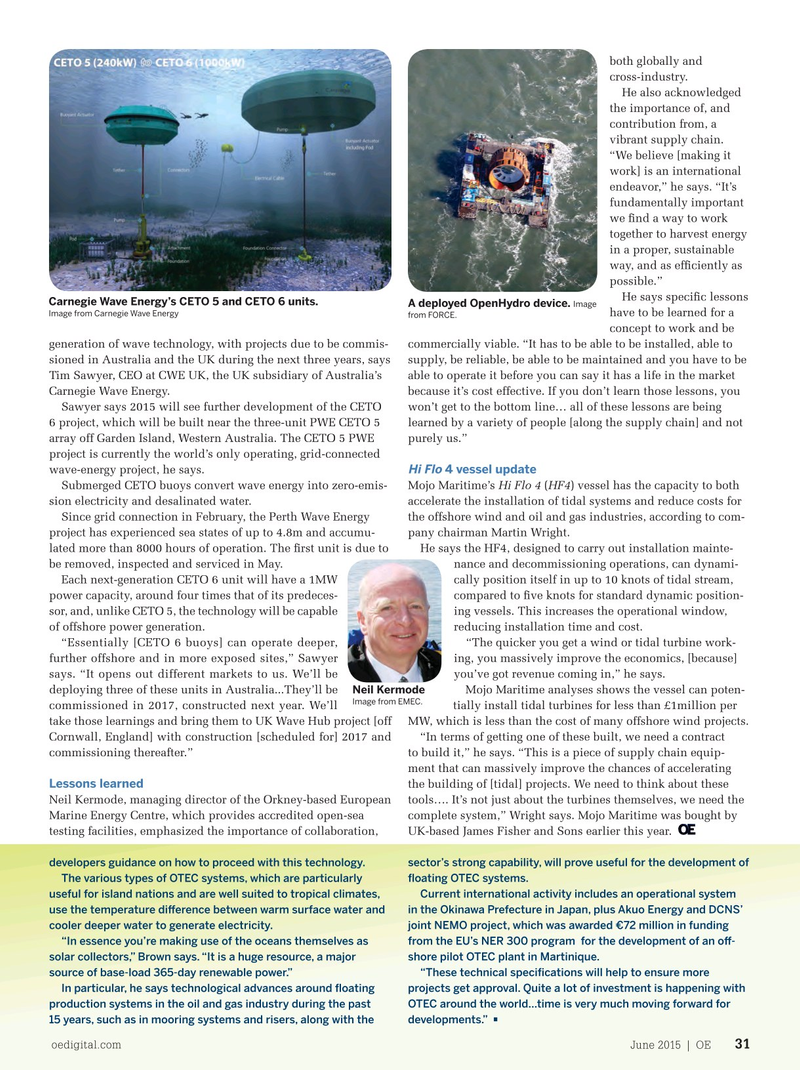
Page 29: of Offshore Engineer Magazine (Jun/Jul 2015)
Read this page in Pdf, Flash or Html5 edition of Jun/Jul 2015 Offshore Engineer Magazine
both globally and cross-industry.
He also acknowledged the importance of, and contribution from, a vibrant supply chain. “We believe [making it work] is an international endeavor,” he says. “It’s fundamentally important we ? nd a way to work together to harvest energy in a proper, sustainable way, and as ef? ciently as possible.”
He says speci? c lessons
Carnegie Wave Energy’s CETO 5 and CETO 6 units.
Image
A deployed OpenHydro device. have to be learned for a
Image from Carnegie Wave Energy from FORCE.
concept to work and be generation of wave technology, with projects due to be commis- commercially viable. “It has to be able to be installed, able to sioned in Australia and the UK during the next three years, says supply, be reliable, be able to be maintained and you have to be
Tim Sawyer, CEO at CWE UK, the UK subsidiary of Australia’s able to operate it before you can say it has a life in the market
Carnegie Wave Energy. because it’s cost effective. If you don’t learn those lessons, you
Sawyer says 2015 will see further development of the CETO won’t get to the bottom line… all of these lessons are being 6 project, which will be built near the three-unit PWE CETO 5 learned by a variety of people [along the supply chain] and not array off Garden Island, Western Australia. The CETO 5 PWE purely us.” project is currently the world’s only operating, grid-connected
Hi Flo 4 vessel update wave-energy project, he says.
Submerged CETO buoys convert wave energy into zero-emis- Mojo Maritime’s Hi Flo 4 (HF4) vessel has the capacity to both sion electricity and desalinated water. accelerate the installation of tidal systems and reduce costs for
Since grid connection in February, the Perth Wave Energy the offshore wind and oil and gas industries, according to com- project has experienced sea states of up to 4.8m and accumu- pany chairman Martin Wright.
lated more than 8000 hours of operation. The ? rst unit is due to He says the HF4, designed to carry out installation mainte- be removed, inspected and serviced in May. nance and decommissioning operations, can dynami-
Each next-generation CETO 6 unit will have a 1MW cally position itself in up to 10 knots of tidal stream, power capacity, around four times that of its predeces- compared to ? ve knots for standard dynamic position- sor, and, unlike CETO 5, the technology will be capable ing vessels. This increases the operational window, of offshore power generation. reducing installation time and cost.
“Essentially [CETO 6 buoys] can operate deeper, “The quicker you get a wind or tidal turbine work- further offshore and in more exposed sites,” Sawyer ing, you massively improve the economics, [because] says. “It opens out different markets to us. We’ll be you’ve got revenue coming in,” he says.
deploying three of these units in Australia...They’ll be Mojo Maritime analyses shows the vessel can poten-
Neil Kermode
Image from EMEC.
commissioned in 2017, constructed next year. We’ll tially install tidal turbines for less than £1million per take those learnings and bring them to UK Wave Hub project [off MW, which is less than the cost of many offshore wind projects.
Cornwall, England] with construction [scheduled for] 2017 and “In terms of getting one of these built, we need a contract commissioning thereafter.” to build it,” he says. “This is a piece of supply chain equip- ment that can massively improve the chances of accelerating
Lessons learned the building of [tidal] projects. We need to think about these
Neil Kermode, managing director of the Orkney-based European tools…. It’s not just about the turbines themselves, we need the
Marine Energy Centre, which provides accredited open-sea complete system,” Wright says. Mojo Maritime was bought by testing facilities, emphasized the importance of collaboration, UK-based James Fisher and Sons earlier this year. developers guidance on how to proceed with this technology. sector’s strong capability, will prove useful for the development of
The various types of OTEC systems, which are particularly ? oating OTEC systems.
useful for island nations and are well suited to tropical climates, Current international activity includes an operational system use the temperature di

 28
28

 30
30